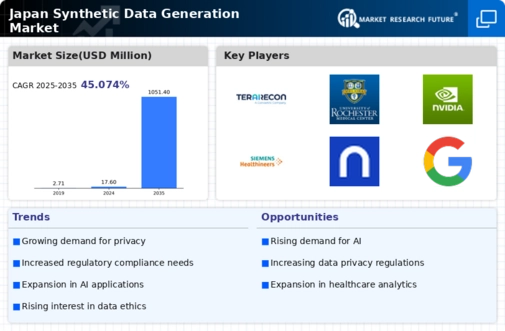Increased Focus on Data Security
In an era where data breaches and cyber threats are prevalent, the synthetic data-generation market is gaining traction due to heightened concerns over data security. Organizations in Japan are prioritizing the protection of sensitive information, leading to a shift towards synthetic data as a secure alternative. By utilizing synthetic datasets, companies can conduct analyses and develop models without exposing real data, thereby mitigating risks associated with data leaks. This trend is reflected in a 40% increase in investments in data security technologies, which is likely to drive the adoption of synthetic data solutions. As businesses seek to enhance their security posture, the synthetic data-generation market is expected to benefit from this growing emphasis on data protection.
Regulatory Support for Innovation
Japan's regulatory environment is increasingly supportive of technological innovation, which is beneficial for the synthetic data-generation market. The government has introduced initiatives aimed at fostering data utilization while ensuring compliance with privacy laws. This regulatory framework encourages organizations to explore synthetic data as a viable alternative to real data, particularly in sectors like healthcare and finance where data sensitivity is paramount. The government's commitment to promoting digital transformation is evident in its investment of over $1 billion in data innovation projects, which is likely to stimulate growth in the synthetic data-generation market. As regulations evolve, companies are expected to adopt synthetic data solutions to navigate compliance challenges effectively.
Growing Demand for Data-Driven Insights
The increasing reliance on data-driven decision-making across various sectors in Japan is propelling the synthetic data-generation market. Organizations are seeking innovative ways to harness data for insights, particularly in industries such as finance and retail. The ability to generate synthetic datasets allows companies to simulate scenarios and analyze potential outcomes without compromising sensitive information. This trend is underscored by a projected growth rate of approximately 25% in the adoption of data analytics tools, which in turn fuels the demand for synthetic data solutions. As businesses strive to enhance operational efficiency and customer experiences, the synthetic data-generation market is positioned to play a crucial role in providing the necessary data infrastructure.
Advancements in Machine Learning Techniques
The rapid advancements in machine learning techniques are significantly impacting the synthetic data-generation market. As algorithms become more sophisticated, the ability to generate high-quality synthetic data that closely mimics real-world data improves. This is particularly relevant in sectors such as automotive and robotics, where training models on diverse datasets is essential for performance. The market is witnessing a surge in demand for synthetic data to enhance machine learning models, with estimates suggesting a growth of 30% in the use of synthetic datasets for training purposes. Consequently, organizations are increasingly investing in synthetic data solutions to leverage these advancements and improve their AI capabilities.
Collaboration Between Industry and Academia
The collaboration between industry and academia in Japan is fostering innovation within the synthetic data-generation market. Universities and research institutions are increasingly partnering with businesses to explore the potential of synthetic data in various applications, from autonomous vehicles to smart cities. These collaborations often lead to the development of cutting-edge technologies and methodologies that enhance the quality and applicability of synthetic data. With research funding in this area projected to reach $500 million by 2026, the synergy between academic research and industry needs is likely to accelerate advancements in the synthetic data-generation market. This collaborative approach not only drives innovation but also ensures that the solutions developed are aligned with real-world challenges.






















Leave a Comment